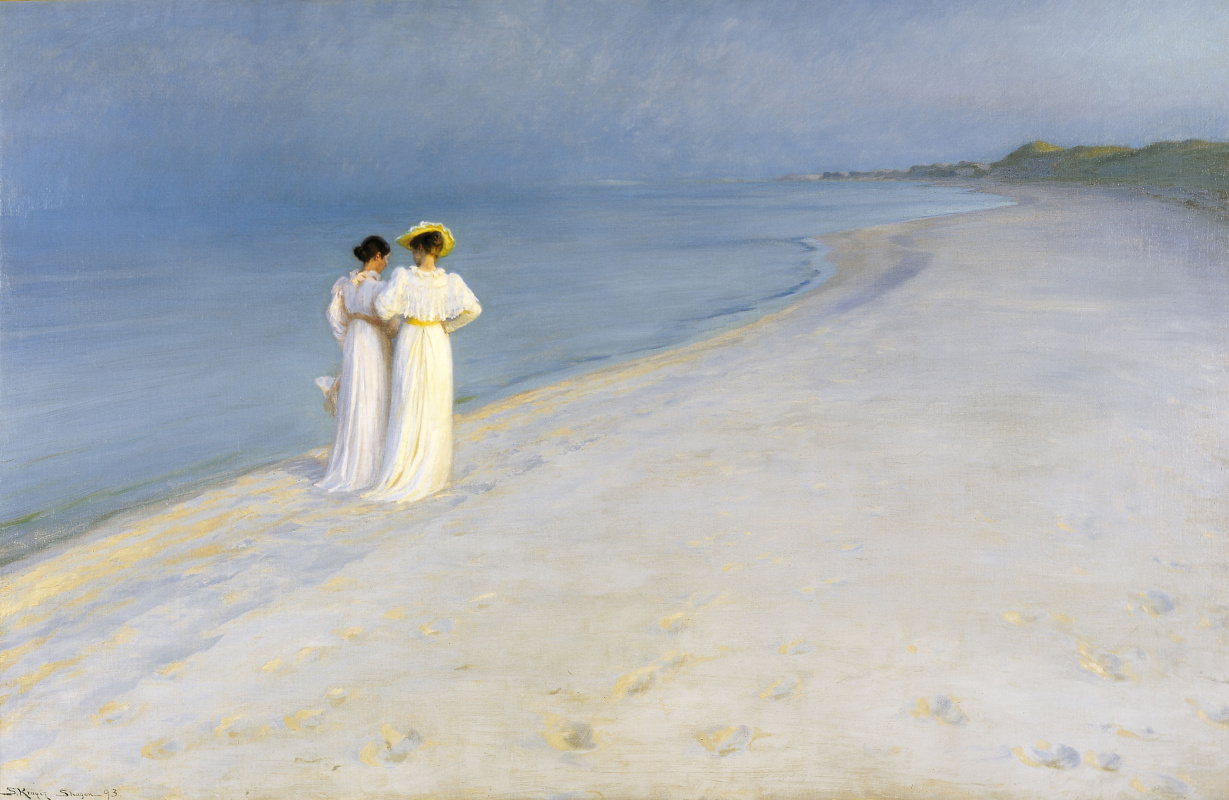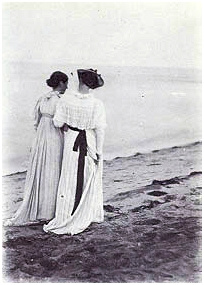log in
Enter site
Login to use Arthive functionality to the maximum
Summer evening on the southern beach of Skagen. Anna Anker and Marie krøyer
Peder Severin Krøyer • Painting, 1893, 100×150 cm
Description of the artwork «Summer evening on the southern beach of Skagen. Anna Anker and Marie krøyer»
"The blue hour" – it is dusk, the day is over, night that's come into its own. In this short period of time Skagen poured out unimaginable light: cold, shining, as if torn sky overhead, and through it flows that a mere mortal eye can perceive-it's hard. The horizon line dissolves between the sea and the sky, the moon and the sun somewhere in there, and... "Skagen can look so terribly dull in the bright sunlight (...) but when the sun sets when the moon rises out of the sea..."– that Krøyer takes the brush and makes it visible and the impossible seem tangible. "Summer evening on the South beach of Skagen" considered the pinnacle of the so-called "blue period" of Krøyer's masterpieces, through which we see the awesome skies of Skagen in all its glory.
Receding woman in the painting – the artist's wife Marie and her friend, the artist Anna Anker. After one dinner party in the house of Creierul guests went for a walk. Then the artist and took the photo where you captured Anna and Marie. In the process of painting Krøyer wrote three options. Two of them are stored in the hirschsprungske collection (1, 2), and one left in a closed private meeting.
Women dressed in white dresses, arm in arm they walk along the shore. In the sand blue-pink reflections of the setting sun. The sky and the sea surrounded by women endless blue – the one for which words are not invented. It is believed that the Krøyer's blue period was influenced by Whistler in particular, his passion for created in the twilight landscape (1, 2) But of course the colours of these two artists are totally different.
It is interesting to compare this painting with another work, "A walk on the beach scienscope" written by Krøyer in the last year of life. Here women are not removed, and go towards the viewer (and artist). From left to right: Vibeke (daughter of Krøyer and Marie) remaining with him after the divorce of his parents, Hennie, Brodersen – a woman who spent the last years of his life, and Elizabeth, the daughter of Henny. The symbolism of the researchers see that the three depicted in the same place almost, but they do not leave artist. But to the level of "Summer nights" this work falls short...
We met the original version, according to which neverthemore and secret longing this picture beat Edvar Munch in some of his works, for example, "Melancholy". We this view is not shared, perhaps, but the readers will not hold out.
Author: Alain Esaulova
Receding woman in the painting – the artist's wife Marie and her friend, the artist Anna Anker. After one dinner party in the house of Creierul guests went for a walk. Then the artist and took the photo where you captured Anna and Marie. In the process of painting Krøyer wrote three options. Two of them are stored in the hirschsprungske collection (1, 2), and one left in a closed private meeting.
Women dressed in white dresses, arm in arm they walk along the shore. In the sand blue-pink reflections of the setting sun. The sky and the sea surrounded by women endless blue – the one for which words are not invented. It is believed that the Krøyer's blue period was influenced by Whistler in particular, his passion for created in the twilight landscape (1, 2) But of course the colours of these two artists are totally different.
It is interesting to compare this painting with another work, "A walk on the beach scienscope" written by Krøyer in the last year of life. Here women are not removed, and go towards the viewer (and artist). From left to right: Vibeke (daughter of Krøyer and Marie) remaining with him after the divorce of his parents, Hennie, Brodersen – a woman who spent the last years of his life, and Elizabeth, the daughter of Henny. The symbolism of the researchers see that the three depicted in the same place almost, but they do not leave artist. But to the level of "Summer nights" this work falls short...
We met the original version, according to which neverthemore and secret longing this picture beat Edvar Munch in some of his works, for example, "Melancholy". We this view is not shared, perhaps, but the readers will not hold out.
Author: Alain Esaulova



